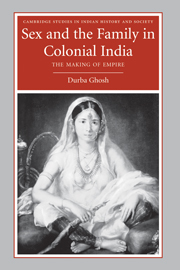Book contents
- Frontmatter
- Contents
- Paintings credits
- Acknowledgments
- Introduction
- 1 Colonial companions
- 2 Residing with begums: William Palmer, James Achilles Kirkpatrick and their “wives”
- 3 Good patriarchs, uncommon families
- 4 Native women, native lives
- 5 Household order and colonial justice
- 6 Servicing military families: family labor, pensions, and orphans
- Conclusion
- Bibliography
- Index
- Miscelloneous Endmatter
6 - Servicing military families: family labor, pensions, and orphans
Published online by Cambridge University Press: 05 August 2014
- Frontmatter
- Contents
- Paintings credits
- Acknowledgments
- Introduction
- 1 Colonial companions
- 2 Residing with begums: William Palmer, James Achilles Kirkpatrick and their “wives”
- 3 Good patriarchs, uncommon families
- 4 Native women, native lives
- 5 Household order and colonial justice
- 6 Servicing military families: family labor, pensions, and orphans
- Conclusion
- Bibliography
- Index
- Miscelloneous Endmatter
Summary
Hasan Shah's novel, Nashtar, written in Persian in 1790, describes a romance between a munshi and a native dancing girl. The story begins when a troupe of dancing girls and the European military regiment to which they are attached arrives in Kanpur. The novel's heroine is a seemingly virtuous dancing girl, Khanum Jan, who refuses the attentions of an English officer, Ming-sahib, instead favoring his Persian-speaking munshi, Hasan Shah. The dancing troupe's interactions with the British military cantonment at Kanpur shows the ways in which military activities produced a complex contact zone, bringing local women and their associates into servicing the needs of British soldiers, offering entertainment, sex, companionship, and other personal services in exchange for a livelihood. As spaces in which different populations mixed, military camps and cantonments became central sites through which the East India Company established its political authority and continued to define who its subjects were. By regulating who would receive financial allowances from the military department and its charities and by categorizing these camp populations using racial markers, the military's bureaucracies were at the forefront of establishing the priorities of the emergent colonial government and its efforts to socially engineer productive populations from the families that became attached to military regiments.
- Type
- Chapter
- Information
- Sex and the Family in Colonial IndiaThe Making of Empire, pp. 206 - 245Publisher: Cambridge University PressPrint publication year: 2006
- 1
- Cited by



